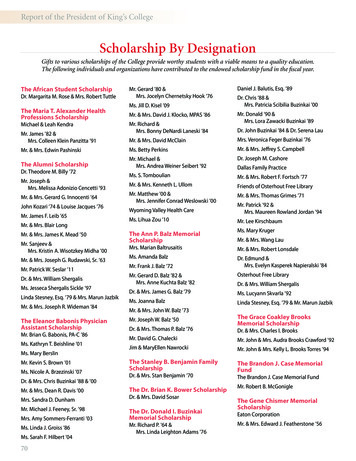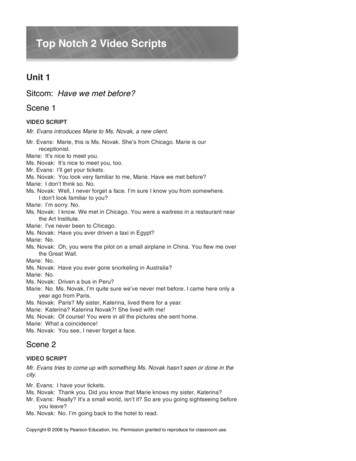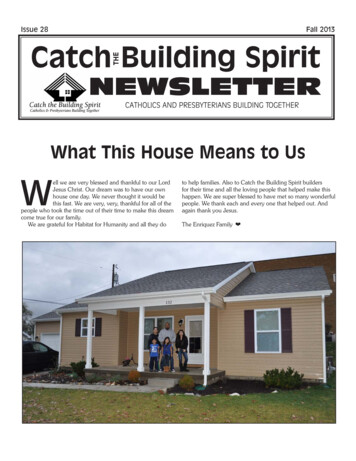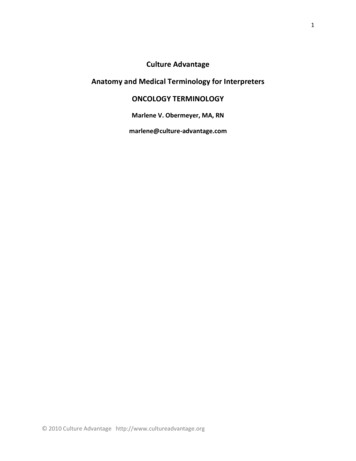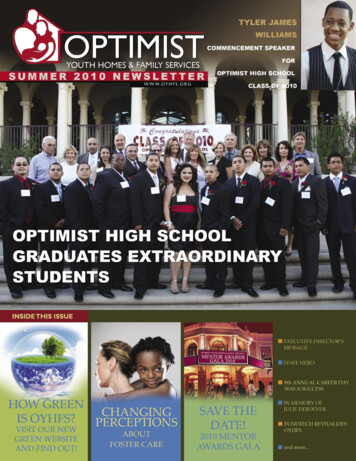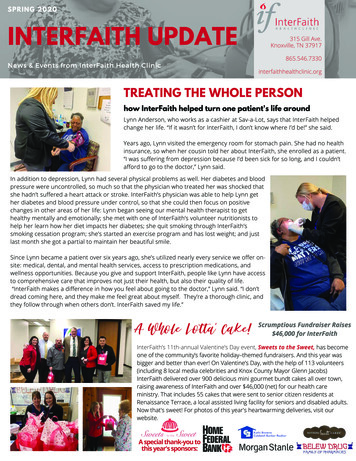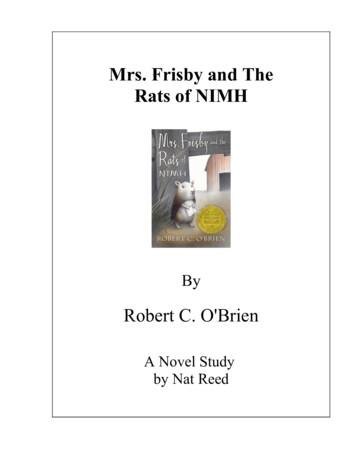
Transcription
Mrs. Frisby and TheRats of NIMHByRobert C. O'BrienA Novel Studyby Nat Reed
Mrs. Frisby And The Rats Of NimhBy Robert C. O’BrienTable of ContentsSuggestions and Expectations . . .3List of Skills . . .4Synopsis / Author Biography . .5Student Checklist . .6Reproducible Student Booklet . . .7Answer Key . .About the author: Nat Reed has been a member of the teaching profession for morethan 30 years. He is presently a full-time instructor at Trent University in the TeacherEducation Program. For more information on his work and literature, please visit thewebsites www.reedpublications.org and www.novelstudies.org.Copyright 2012 Nat ReedAll rights reserved by author.Permission to copy for single classroom use only.Electronic distribution limited to single classroom use only.Not for public display.270
Mrs. Frisby and the Rats of NIMHBy Robert C. O’BrienSuggestions and ExpectationsThis 76 page curriculum unit can be used in a variety of ways. Each chapter of the novel studyfocuses two chapters of Mrs. Frisby and the Rats of NIMH and is comprised of four differentactivities: Before You ReadVocabulary BuildingComprehension QuestionsLanguage and Extension ActivitiesA principal expectation of the unit is that students will develop their skills in reading, writing,listening and oral communication, as well as in reasoning and critical thinking.Links with the Common Core Standards (U.S.)Many of the activities included in this curriculum unit are supported by the CommonCore Standards. For instance the Reading Standards for Literature, Grade 5, makesreference toa) determining the meaning of words and phrases. . . including figurative language;b) explaining how a series of chapters fits together to provide the overall structure;c) compare and contrast two characters;d) determine how characters respond to challenges;e) drawing inferences from the text;f) determining a theme of a story . . . and many others.Students can work on the activities at their own pace. Every activity need not be completed by allstudents. A portfolio cover is included as well as a Student Checklist.Themes which may be taught in conjunction with the novel include rats and mice, farms andfarming, medical testing using laboratory animals, courage and self-sacrifice, perseverance,teamwork, prejudice / profiling, friendship, the importance of family and friends.3
Mrs. Frisby and the Rats of NIMHBy Robert C. O’BrienList of SkillsVocabulary Development1. Locating descriptive words / phrases2. Listing synonyms/homonyms3. Identifying / creating alliteration4. Use of capitals and punctuation5. Identifying syllables6. Identify foreshadowing.7. Identify personification.8.9.10.11.12.13.14.Use of singular / plural nounsListing compound wordsIdentifying parts of speechDetermining alphabetical orderIdentification of root wordsIdentify/create similesIdentification of cliffhangers.Setting Activities1. Summarize the details of a settingPlot Activities1. Complete a time line of events3. Identify the climax of the novel.4. Five W’s Chart2. Identify conflict in the storyCharacter Activities1. Determine character traits3. Relating personal experiences2. Protagonists and antagonists4. Comparing two CharactersCreative and Critical Thinking1.2.3.4.5.ResearchWrite a newspaper storyWrite a letter to a friendComplete an Observation ChartComplete a KWS Chart6. Conduct an interview7. Write a description of personal feelings8. Write a book review9. Complete a Comparison Chart10. Complete a Research OrganizerArt Activities1. A Storyboard2. Create a collage3. Design a cover for the novel4. Design an Information Card4
Mrs. Frisby and the Rats of NIMHBy Robert C. O’BrienSynopsisMrs. Frisby, a widowed mouse with four small children, is faced with a terrible problem. Shemust move her family to their summer quarters immediately, or face almost certain death. But heryoungest son, Timothy, lies ill with pneumonia and must not be moved. Fortunately, sheencounters the rats of NIMH, an extraordinary breed of highly intelligent creatures, who come upwith a brilliant solution to her dilemma. And Mrs. Frisby in turn renders them a great service.[Courtesy of the publisher]Check out the clips for Mrs. Frisby and the Rats of NIMH –movie and book trailers - on YouTubeAuthor BiographyRobert C. O’BrienRobert Lesley Conly (Robert C. O'Brien - 1918 – 1973) wasan American author best known for his 1975 novel Z forZachariah. This renowned novel was publishedposthumously and won an Edgar Award. For many years,O’Brien was a journalist for National GeographicMagazine. O'Brien married Sarah McCaslin in 1943. Thecouple had four children. The marriage lasted until hisdeath thirty years later in 1973.O'Brien is also known for his 1971 novel Mrs. Frisby andthe Rats of NIMH. This novel won the prestigious JohnNewbery Medal. His works have also been made intomovies including The Secret of NIMH (1982), Play for Today (1970), Z for Zachariah(1984), and The Secret of NIMH 2: Timmy to the Rescue (1998).The film Z for Zachariah (2011) is in production.Adapted from website: http://www.imdb.com/name/nm0639791/bio5
Mrs. Frisby and the Rats of NIMHBy Robert C. O’BrienStudent ChecklistStudent Name:AssignmentGrade / Level6Comments
Mrs. Frisby andthe Rats of NIMHBy Robert C. O’BrienName:7
Mrs. Frisby and the Rats of NIMHBy Robert C. O’BrienChapter 1 - The Sickness of Timothy FrisbyChapter 2 - Mr. AgesBefore you read the chapters:The protagonist in most novels features the main character or “good guy”. Theprotagonist of Mrs. Frisby and the Rats of NIMH is quite unique – Mrs. Frisby, awidowed field mouse with four children Think back on some of your favorite charactersfrom past novels you have read or movies you’ve seen. What do you think makes for anespecially intriguing protagonist?Vocabulary:Choose a word from the list to complete each f she continues to complain about her health all the time, people will start thinkingshe is a .2.Filing all of those folders will be a very task.3.“Clean up your room,” Aunt Gertie shouted .4.This particular key will give you to the safe in Mr. Chesterton’s office.5.No one expected him to uninjured from the wreck.8
6.Gold coins are very in today’s economy.7.You must give that cord a tug in order to start the outboard motor.8.The injured trapper spent the afternoon the edge of the forestfire.9.His fever was so high that Timothy soon became .10.It was plain to see how the detective was in asking the suspectquestion after question.Questions1. An exciting story relies on a crisis to make things more interesting for the reader.What crisis is described in the first chapter?2. What did Mrs. Frisby assume happened to the animal(s) who stored the food thatshe found.3. For each of Mrs. Frisby’s children, write one thing which would describe him/her.TeresaMartinCynthiaTimothy4. Although Timothy was quite frail, what did he have going for him?9
5. Define hypochondriac.6. Why was it dangerous for Mrs. Frisby to venture too close to the farmhouse andbarn?7. Why did she go to see Mr. Ages? What did he advise her?8. What traumatic event seemed to be the beginning of Timothy’s health problems?9. Mr. Ages tells Mrs. Frisby that the medicine will help Timothy recover, what sternwarning does he also offer? For how long will this be in effect?10. Foreshadowing is a literary device where the author provides a hint as to whathappen later in the story. How might the warning of Mr. Ages be an example of this?11. Describe the setting of these chapters.10
Language ActivitiesA. The Field MouseThe Frisbys are field mice living on the Fitzgibbons’ farm. Also knownas a meadow vole in North America, the field mouse is active yearround, usually at night. It also digs underground burrows where itstores food for the winter. Using resources in your school library or onthe Internet, investigate additional information about this industriouslittle rodent. Below record three fascinating facts from your researchand include a drawing of the field mouse.11
B. Personificationis giving human qualities to something that is not human.Examples from Chapter 2 include: There were harsher plants as well. . . In this exampleplants is personified - it is harsher, an attribute usually given to a person. Anotherexample is found in the very next paragraph: . . . the dry skeletons of the weeds . . . Herethe weeds are described as skeletons.a) Why do you think personification is a literary device used by many authors?b) Create your own example of personification.c) Bonus: Keep your eyes open for another example of personification. When you findone, come back to this page and record it below.C.The word “weed” can be used as a noun or a verb, depending onthe sentence. Use your imagination and write sentences to illustratehow this word can be used as both a noun and a verb.WEEDNounVerb12
Extension ActivitiesStoryboardA storyboard is a series of pictures that tell about an important event in a story. Astoryboard can tell the story of only one scene – or the entire novel.Complete the storyboard below illustrating the events described in the first two chaptersof Mrs. Frisby and the Rats of NIMH. You may wish to practice your drawings on aseparate piece of paper.12345613
Mrs. Frisby and the Rats of NIMH By Robert C. O’Brien Chapter 1 - The Sickness of Timothy Frisby Chapter 2 - Mr. Ages Before you read the chapters: The protagonist in most novels features the main character or “good guy”. The protagonist of Mrs. Frisby and the Rats of NIMH is quite


